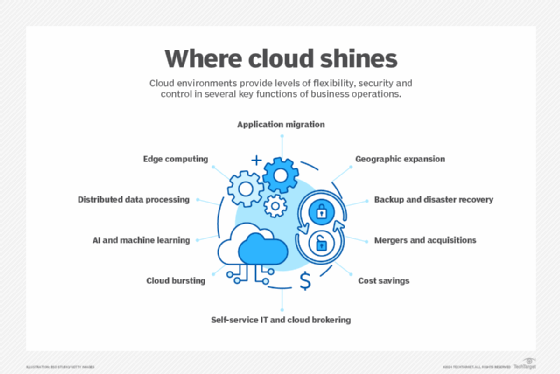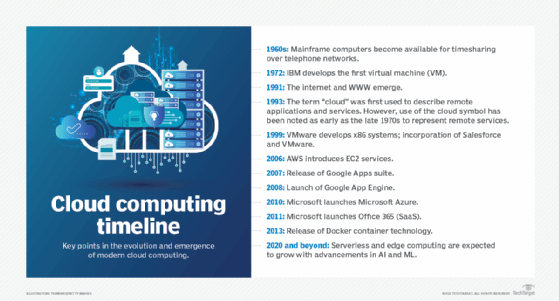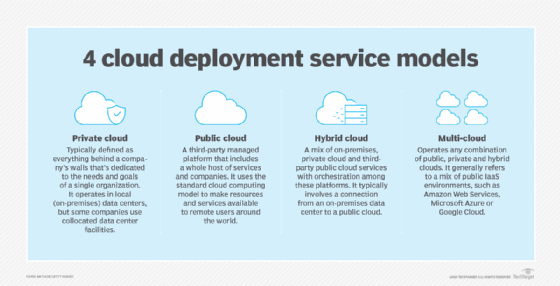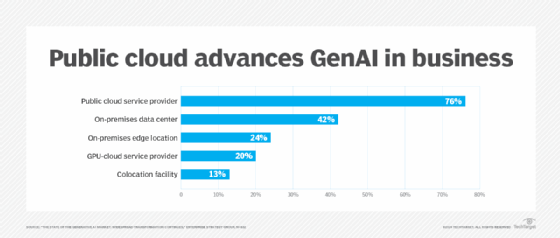The history of cloud computing explained
Get a clear view of cloud's historical milestones, how it evolved into the juggernaut it is today and transformed the commercial and working worlds for businesses and consumers.
Cloud computing services are the ultimate expression of computing-as-a-utility. Just as individuals and businesses pay for public utilities such as electricity and water, the cloud has made computing resources available on demand. Cloud resources can be used as needed so users pay only for the resources or services consumed.
The economic and strategic importance of cloud computing is substantial. Before cloud computing, businesses had little choice but to build, operate and maintain their own computing resources and services typically consolidated into physical data centers. The emergence of public cloud providers has enabled businesses to shift capital costs and operational burdens to the providers in exchange for recurring identifiable monthly expenses.
Cloud computing today has become indispensable for most households and businesses. It was instrumental in minimizing the social disruption and economic destruction of lockdowns and restrictions due to the COVID-19 pandemic. In effect, cloud computing enabled businesses, their employees and partners, to operate workloads and deliver data with a high degree of remote autonomy so people could work from home or nearly any location where network access to the cloud was available.
Cloud computing is typically implemented as a public cloud. Third-party enterprises include Amazon Web Services (AWS), Microsoft Azure and Google Cloud, which have built global networks of cloud data centers divided into geopolitical regions. Cloud computing also can be implemented as a private cloud. Business resources and services can be delivered from the privately owned data center configured with many of the DIY and scalability benefits found in public clouds. Cloud computing comprises information, application and computing utilities and takes form as IaaS, PaaS and SaaS offerings.
The pandemic accelerated business adoption of the cloud as companies turned to online services and infrastructure to accommodate remote employees and customer demand for online meetings, events and commerce. Gartner projects 2025 end-user spending on public cloud worldwide to reach $723 billion, up more than 20% from last year.

What was there before cloud computing?
As businesses migrate workloads from local data centers to cloud providers and build new cloud-native applications from the ground up, the cloud is systematically displacing traditional enterprise data centers. But the concept of computing as a utility or service is not new. Businesses didn't always own and operate private data centers.
Early in our modern technological era, IT capabilities were frequently delivered as a service. Until the introduction of minicomputers -- such as the Digital Equipment PDP and VAX series that proliferated across business and academia in the 1970s -- only the largest enterprises and government agencies could afford to buy and operate a mainframe. Time-sharing solved this cost and availability problem, inventor John McCarthy wrote, via an operating system that allowed many users to have simultaneous access to a large and powerful mainframe computer that was shared through remote terminals operating over dial-up (telephone-based) network connections.
Smaller businesses that couldn't afford to own or operate a mainframe could potentially utilize the computing capabilities of larger businesses that did own and operate mainframes. The data processing needs of smaller companies fueled the rise of time-sharing as a business, with hundreds of companies providing services by the mid-1960s. While most of these services companies are lost to history, some like IBM Global Services, DXC Technology (successor to Electronic Data Systems and Computer Sciences Corp.) and NTT Data (which acquired Perot Systems) survive as part of full-service IT providers.
The rise of minicomputers was followed by PCs and Unix workstations along with Windows and Unix servers. Simple and inexpensive computers could be deployed locally, destroying what was left of the time-sharing market and paving the way for modern data centers and subsequently cloud computing. Though virtualization had long been part of IBM's mainframe operating system, the final piece of technology was the reinvention of VMs for x86 systems by the founders of VMware in 1999. VM technology provided the foundation for cloud compute instances and soon led to the virtualization of other infrastructure resources that constituted the early cloud services, including the following:
- Storage (block volumes, network file shares and object buckets).
- Networks (VPNs and virtual LANs).
- Application containers (Docker runtime).
- Network control plane and service (software-defined network and network functions virtualization).
By the dawn of the 21st century, all the fundamental networking, computing and virtualization elements were available to support basic computing as a remote service using a pay-as-you-go (PAYG) model, signaling the first iterations of a public cloud.
Who invented cloud computing?
Cloud computing is a complex platform involving myriad technologies. Cloud services rely on several core components, which makes ascribing authorship to a single individual or entity impossible. The various technologies and their originators are in the following table.
| Cloud component | Inventor |
| x86 servers and operating systems (Windows, Linux) | Intel, Microsoft and the Linux project |
| x86 virtualization | VMware; later Cambridge University with the Xen hypervisor and Microsoft's Hyper-V hypervisor |
| Internet and widespread high-speed internet access | Early packet-switched networking (ARPAnet) -- Bob Kahn, Vint Cerf, et al.; TCP/IP ecosystem (routing protocols, DNS, etc.) -- various Telcos and broadband providers; the World Wide Web -- Vint Cerf and Tim Berners-Lee; J.C.R Licklider conceived the idea of a universal network, leading to the eventual development of ARPAnet. |
| Application service providers (ASPs) and multi-tenant SaaS providers | ASPs -- Jostein Eikeland, founder of TeleComputing; SaaS -- Marc Benioff, Larry Ellison and Evan Goldberg of Oracle |
| IaaS | Amazon Web Services; later Microsoft Azure and Google Cloud Platform |
Tracing the etymology of the term cloud is difficult since the cloud metaphor was widely used by early internet designers to denote the wide-area routing and switching infrastructure between network nodes. Perhaps the first use of cloud as a term to describe a collection of remotely executing applications and services came from Andy Hertzfeld, one of the creators of the original Apple Mac computer, who later co-founded General Magic in 1990. In a 1994 Wired article, Hertzfeld described the startup's new Telescript system as follows:
The beauty of Telescript is that now, instead of just having a device to program, we now have the entire Cloud out there, where a single program can go and travel to many different sources of information and create sort of a virtual service.
The term cloud was widely used in 2006 when Amazon launched AWS with the Elastic Compute Cloud (EC2) service.
1990s: Precursors to cloud computing
The precursors to cloud computing include mainframe and minicomputer time-sharing, ASPs and consumer information services such as CompuServe and AOL. They demonstrate that the impetus for remote services, whether delivered over the internet or a dial-up line, was the need for applications and data that couldn't easily, if at all, be provided locally. Although VMs were long part of mainframe systems, early time-sharing uses centered on application processing.
By the late 1990s, ASPs were common, and Oracle visionaries extended the idea to multi-tenant SaaS applications, leading Marc Benioff to leave and found Salesforce while Evan Goldberg stayed on at Oracle and started NetSuite. Complicated enterprise software, such as ERP, CRM and financial systems, are ideal candidates for SaaS due to the cost of the required infrastructure and expertise needed to operate them.
It wasn't until enterprises installed larger internet circuits and executives warmed up to the concept of remotely executing applications that companies like Salesforce took off, with revenue exploding in the 2000s. The popularity of consumer online applications and social networks, such as Evernote, Facebook, Webex and Dropbox, paved the way for business SaaS by demonstrating the cost-effectiveness, convenience, simplicity and reliability of online applications to enterprise executives.

2000s: The modern cloud
Cloud services as broadly understood today -- virtual infrastructure resources, development platforms and complete applications -- emerged in the 2000s. While Benioff was evangelizing the benefits of SaaS business applications, internet businesses such as AWS, Google and Microsoft were building vast data centers to accommodate the rapid growth of online commerce and applications.
Amazon gave rise to the IaaS industry as an outgrowth of previous efforts to create its marketplace for third-party retailers. After building the necessary infrastructure and APIs, some people at the company realized it had unused capacity -- particularly outside peak shopping periods -- that could be rented on demand. AWS was born when S3 storage resources and EC2 compute instances were released in 2006. Microsoft and Google soon followed with cloud services in 2008 -- Azure and Google App Engine, respectively. The same year, NASA released the Nebula platform that evolved into OpenStack, which remains a major framework for cloud services and delivery, especially for private clouds.
Google simultaneously pioneered SaaS productivity applications by releasing the Google Apps suite in 2007. In 2009, Apple introduced limited online document sharing and editing in iWork, while Microsoft joined the SaaS market by launching Office 365 in 2011.
Consumers were first to embrace the cloud via services such as Dropbox, Google Drive, iCloud and other file storage products that replaced email and USB sticks (thumb drives) for file sharing and local hard drives for backup. These same use cases attracted businesses to packaged SaaS backup products and low-cost IaaS storage services such as S3 and Azure Storage for offsite archival. As virtualization overtook enterprise data centers, businesses augmented these storage services with compute instances to create remote disaster recovery environments at a fraction of the cost of dedicated secondary facilities.
2010s: Cloud computing evolves
The nexus of cost-conscious businesses recovering from the 2008 financial crisis and rapidly maturing cloud technology led many businesses to explore cloud services as an alternative to capital-intensive private infrastructure. The PAYG convenience of cloud services fueled organic bottom-up adoption within large enterprises. It enabled teams to begin creating cloud environments from department budgets without going through long capital approval processes for new equipment or supporting complex deployment and maintenance demands that accompany local data centers.
The decade saw an explosion in new business and consumer cloud services along with construction of the hyperscale data centers required to operate them, with Apple iCloud, IBM Cloud and Oracle Cloud all launching. The decade's latter half saw the rise of container infrastructure -- namely, Docker container runtime and image format and the Kubernetes cluster manager -- as a replacement for VMs. Every cloud service soon introduced container management services and hybrid products, such as Docker Enterprise, Red Hat OpenShift and VMware Tanzu, offering workload portability between private and public cloud environments.

2020s: The COVID-19 effect
The overall cloud model had matured by 2020, but continued developments emerged with expanding use cases and proliferating cloud capabilities.
While the onset of the global COVID-19 pandemic was difficult for many small businesses, things couldn't have been better for cloud operators. Enterprise spending on IaaS surged to $37 billion in the fourth quarter of 2020, a 35% jump compared to the same period in 2019, according to Synergy Research.
Businesses turned to cloud services to mitigate disruptions caused by forced remote work and a concomitant shift in business operations and consumer activity online. A report released in 2021 by IT management software provider Flexera revealed that 90% of surveyed IT professionals acknowledged post-pandemic cloud usage to be higher than planned, with 29% reporting a significant increase in cloud usage and only 10% making cuts in cloud spending. Many respondents cited an urgent need for capacity and the convenience of deploying cloud services in light of pandemic restrictions. The mass migration of business meetings and schooling online was also a boon for SaaS vendors, particularly those with video conferencing services such as Microsoft Teams and Zoom.
Cloud providers have aggressively added new services and capabilities over the past few years. Some of the more notable advancements have been the release of AI and machine learning (ML) services, including generative AI (GenAI) services on Oracle Cloud, Google's Vertex AI services and Amazon SageMaker. Flexera noted that 38% of respondents to its 2024 State of the Cloud Report are experimenting with GenAI, while 47% are using GenAI in production at some level.
Businesses have also placed greater emphasis on cloud cost control. Broad cloud adoption quickly taught businesses that cloud services aren't necessarily cheaper than on-premises data centers. Business leaders recognized that cost-effectiveness and business value were more important than bottom-line cloud costs. Organized cost analysis and management processes, such as FinOps, gained traction as a means of collaborative cloud cost management companywide. More than half of businesses responding to the 2024 Flexera cloud report said they prioritize cloud cost optimization and engage a FinOps team to advise, manage or execute their optimization strategies.

Future of cloud computing: 2025 and beyond
Aside from the vast expansion of cloud usage, the next few years will see businesses take an increasingly nuanced, strategic approach to cloud services. Businesses will select the best balance of public, private, hybrid and multi-cloud infrastructure, find optimal cloud products and providers for their needs and hedge lock-in and loss-of-service risk via a heterogeneous cloud environment. Major cloud developments in the near future include the following:
- Edge computing. The cloud is becoming increasingly distributed and moving ever closer to the edge as 5G, IoT and application demands push more cloud capabilities closer to businesses and users. The value of edge computing is particularly noteworthy in AI/ML deployments where huge amounts of data and decision-making move closer to the data sources.
- Autonomous management. Clouds are moving toward autonomous management, enabling AI/ML capabilities to use extensive performance and behavioral data to exert autonomous and automatic control over cloud infrastructure. The goal is to bring more operational efficiency and security to the cloud infrastructure and users.
- Quantum computing. New computing paradigms such as quantum computing will change the performance and security characteristics of future computing by supporting principles of quantum mechanics to operate on data with increased speed and complexity. Although the exact evolution of quantum computing is still unclear, its potential is driving serious business interest.
- Security. Security is a growing concern that's forcing cloud adopters to use layered security paradigms and secure access service edge approaches to maintain security and compliance in the cloud. Future investments in security technologies will bring stronger data access and usage controls to protect business data in the cloud.
- Regulation. The cloud, and the entire internet, is fragmenting as political differences, diverging regulations, differing industry standards and trade protectionism create complex compliance environments between various countries and regions. At the same time, data privacy, security, regulatory and governance challenges have skyrocketed as cloud services become an integral part of daily business activities.
- Environment. Environmental considerations are forcing cloud providers to change the way they use energy and manage the environmental effects of their cloud businesses. Cloud providers must account for their carbon footprint and implement efficient and sustainable/renewable energy alternatives for their operations to meet the electricity demands of data centers and GenAI.
Editor's note: This article has been updated to reflect the latest public cloud developments and historical milestones.
Stephen J. Bigelow, senior technology editor at TechTarget, has more than 30 years of technical writing experience in the PC and technology industry.







